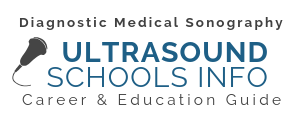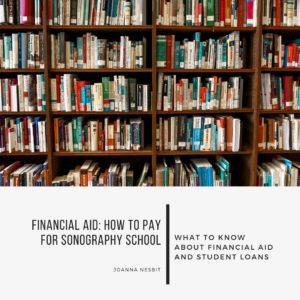You might think the Free Application for Federal Student Aid, aka FAFSA, is only for federal grants and federal student loans. But sonography schools also use the FAFSA to calculate state aid, state scholarships, and institutional aid or scholarships (money from the school itself). Private scholarships also sometimes require the FAFSA.
The FAFSA opens on October 1 every year. That’s not the deadline; that’s when it opens—and the federal deadline is June 30. But each state and institution has their own deadlines for financial aid and scholarships. Be sure to check yours so you don’t miss out. Financial Aid may be available if you qualify. Here’s an overview of types of financial aid available.
Federal Financial Aid
Grants. The most common federal grants are the Pell Grant and FSEOG Grant for undergraduate sonography students. These grants are given for financial need, and can be partial or the full amount. The full Pell Grant is $6,895 (2022-23). Each year it goes up a little bit, and if you qualify you’ll receive it. FSEOG Grants, ranging from $100 to $4,000 for exceptionally needy students, are awarded by the schools themselves. Not all ultrasound technician schools participate in the program. The studentaid.gov website gives an overview of all available federal grants.
Work-Study.You might qualify for work-study, which pays you for a part-time job while in school. Work-study can be federal, state-sponsored, or institutional-sponsored. These jobs can be on or off campus. You’ll probably need to check the school’s student employment board and do the job hunting yourself, but talk to your school about how it works. If you work off-campus, the job will likely be relevant to your degree. Even if you don’t qualify for work-study, campuses offer other part-time jobs.
Put your best foot forward! When preparing your application, include a resume to highlight your skills and achievements.
Student loans. The best loans come from the federal government. See the section below for more details on federal and private loans.
According to the U.S. Trade Commission, “unscrupulous companies guarantee or promise scholarships, grants or fantastic financial aid packages. Many use high pressure sales pitches at seminars where you’re required to pay immediately or risk losing out on the ‘opportunity.’” Visit consumer.FTC.gov to learn more.
State Aid and Scholarships
Most states offer a state need grant or scholarship (or both) to qualifying in-state students, so going to sonography school in-state can benefit you. Some state scholarships have strict qualifying guidelines, like you need to attend a 4-year university, so read the fine print carefully. Some states have programs for different levels of income, like California’s Cal Grant program and Middle Class Scholarship. And some states offer free tuition for community or technical college, like Oregon, Nevada, and Tennessee.
To learn about state resources, start with your state’s student aid commission (or similar name). Also, search your state name and scholarships. Finally, talk to your high school guidance counselor or college financial aid office about available state resources.
If you are undocumented, check to see if your state offers a state financial aid form, like Washington’s WASFA or the California Dream Act Application, to use instead of the federal FAFSA. You might qualify for state aid even if you’re not eligible for federal aid.
What to Know About Student Loans
Federal student loans tend to be the best option. They come with low fixed interest rates and different options for paying them off, like the income-driven repayment plan. They also have annual limits to keep you from getting into too much debt. If they don’t cover enough of your cost, the private student loan market is your next stop. Here’s what to know.
Federal student loans. These come in two types: Direct Unsubsidized and Direct Subsidized, sometimes called Stafford loans.
- The Direct Unsubsidized loan is available to any undergraduate, regardless of income level. Interest begins accruing when the loan is disbursed. Many college experts recommend paying the interest while you’re in school to avoid increasing the loan balance.
- The Direct Subsidized loan is available to undergraduates who demonstrate need. Your “expected family contribution” is used to calculate your eligibility, and even middle-income students can qualify. The federal government pays the interest on the loan while you’re enrolled half time or more and until six months after graduation.
- Annual loan limits are $5,500 for freshmen (no more than $3,500 subsidized); $6,500 for sophomore year (up to $4,500 subsidized), $7,500 for junior and senior year (up to $5,500 subsidized), and $4,000 for a fifth year.
- Your school determines the actual loan amount you’re eligible for. You might not receive the entire annual amount, depending on other aid you receive.
Private student loans. You can find private student loans through private lenders, like banks or credit unions, if the federal student loan doesn’t cover enough of your cost. Most sonography students require a co-signer, usually a parent, if they don’t have an established credit record.
Parent PLUS loans. If your parents plan to help with costs, this federal loan is for them. The loan comes with a fixed interest rate of 6.28 percent (2021-22). It’s their loan, not yours. That’s important for them to understand.
Do You Qualify as an Independent Student?
If you don’t meet the federal definition of an independent student, you will be required to include your parents’ financial information on the FAFSA until you’re 24, the automatic age for independence. Read up on student status to determine if you’re a dependent or independent student. Also talk to your school’s financial aid office if you believe you should qualify as independent.


